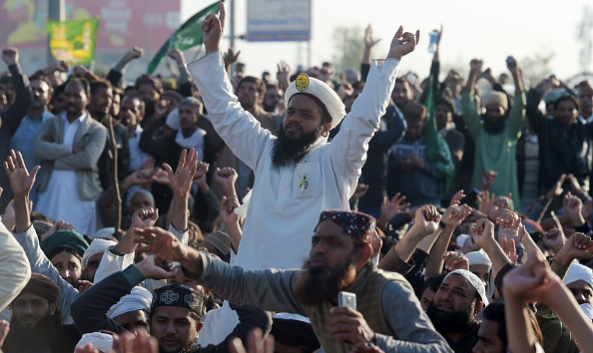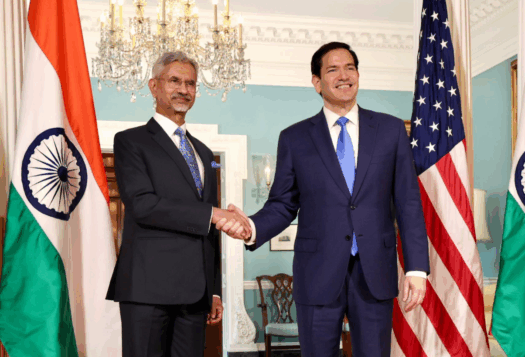
After three weeks, a series of mass protests related to a blasphemy controversy involving Pakistan’s law minister, Zahid Hamid, finally ended late last month. Khadim Hussain Rizvi, chief of the hardline political party Tehreek-e-Labaik ya Rasool Allah (TLYR) that organized the country-wide protest, reached an agreement with the government mediated by the Pakistan Army.
TLYR recently demonstrated its political salience by winning more than seven thousand votes in bi-elections in Lahore in September. For perspective, TLYR’s vote totals were greater than more established parties like the Pakistan People’s Party (PPP) and Jamaat-e-Islami (JI). Throughout much of November, hundreds of TLYR supporters choked the Islamabad Highway in the nation’s capital, calling for the removal of Hamid as well as strict action against those who were behind the modification of the Khatam-e-Nabuwwat clause (faith in the finality of the Prophethood) in the oath taken by Pakistani lawmakers. Even though the Pakistani government ruled the amendment of the clause a “clerical error” and rectified it soon after, the protestors termed the action blasphemy and came out on the streets.
While the protests have ended with the resignation of Hamid, the incident is a cause for concern as it demonstrates the susceptibility of a sizeable portion of the population to religious extremism. The main vector of such messaging is social media. The protestors in Islamabad used social media platforms such as Twitter, Facebook, WhatsApp, and YouTube to disseminate their messages that included hateful content against Pakistan’s religious minorities, which were livestreamed across a variety of online forums. According to several sources, the TLYR protests incited supporters to violence, resulting in the torching of public property, attacks on police officers and lawmakers, and the deaths of at least six protesters.
While the quick, unfiltered flow of information and news online can be a benefit to larger society, when such messaging advocates violence, authorities should take appropriate action. As such, the Pakistani government should take a multifaceted approach to countering violent rhetoric, including implementing existing laws and partnering with international tech companies. While many countries struggle with the question of how to balance between protecting national security and upholding free speech, it is important for the Pakistani government to take a clear stand on radicalization and incitement to violence.
TLYR Protests and Lackluster Social Media Regulation
The government’s efforts in countering hate speech and content inflaming religious sentiments during these protests left a lot to be desired. As it stands, both the Prevention of Electronic Crimes Act (PECA) 2016 and the National Action Plan (NAP) have provisions to counter hate speech in traditional media and online. The Pakistani government also has institutions like the National Counter Terrorism Authority (NACTA) and the Federal Investigation Agency (FIA), which have the mandate to counter extremism and hate speech.
Yet, the government did not take significant steps to counter online extremist activities during TLYR’s sit-in. Despite possessing legal authority, FIA and NACTA did not take any action against protestors that would dissuade them from posting such content. Pakistan is not unique in facing this complex problem; many countries are still struggling to identify a workable solution to counter extremist content on social media. However, that cannot be an excuse not to address verbal and written threats of violence and it is this inaction that allowed TLYR to disseminate hate speech and mobilize their supporters. Under PECA 2016, the Pakistani government has the authority to restrict hate speech and extremist propaganda without compromising the essence of Article 19 of the Constitution, which guarantees freedom of speech to Pakistani citizens. While identifying the line between hate speech and free speech is sometimes an immense challenge, the government should take steps to clarify in what cases it will make use of current counter-extremism legislation on the ground and in the virtual domain.

Striking a Balance Between Counter-Extremism and Free Expression
Importantly, civil society groups in Pakistan have raised concerns that PECA 2016 might curtail individuals’ right to expression and restrict open access to information in Pakistan. Given the potential for misuse or over-use by authorities, the government should not solely rely on PECA 2016 to counter violent rhetoric online.
For example, Pakistan should also work with social media conglomerates to combat the spread of digital content that incites violence. Though Facebook, Twitter, and Google have already announced promising forums like the “Global Internet Forum to Counter Terrorism” designed to compile research and solutions on countering extremism, there appears to be little coordination between these companies and Pakistani authorities so far. As such, Pakistan should work out a feasible plan in partnership with international tech giants that restricts content that incites violence or radicalizes vulnerable populations. Implementing best practices in this regard will mitigate violent rhetoric while safeguarding access to social media across the country.
A second action authorities should consider is actively countering extremism through more moderate messaging. Through NACTA, and in tandem with civil society, messages by moderate Islamic scholars should be more widely promoted to counter extremism on social media.
In sum, the dissemination of radical and extremist propaganda on social media will continue to be slow poison in the blood of Pakistani society until proactive, creative, and vigilant action is taken. While the Islamabad protests may be over, such incidents threaten the fabric of Pakistan’s diverse social order, demanding action that respects individual expression while firmly countering extremist and violent messaging.
***
Editor’s note: Click here to read this article in Urdu
Image 1: bm1632 via Flickr (cropped)
Image 2: Aamir Qureshi via Getty


